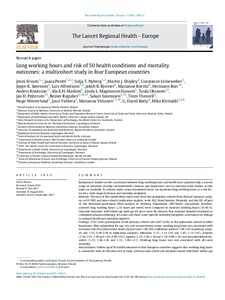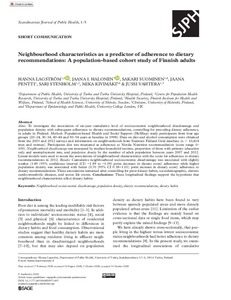Hae
Aineistot 11-20 / 117
Sex Differences in Cardiovascular Outcomes of Older Adults After Myocardial Infarction
<p>Background Evidence on the impact of sex on prognoses after myocardial infarction (MI) among older adults is limited. We evaluated sex differences in long-term cardiovascular outcomes after MI in older adults. Methods and Results All patients with MI ≥70 years admitted to 20 Finnish hospitals during a 10-year period and discharged alive were studied retrospectively using a combination of national registries (n=31 578, 51% men, mean age 79). The primary outcome was combined major adverse cardiovascular event within 10-year follow-up. Sex differences in baseline features were equalized using inverse probability weighting adjustment. Women were older, with different comorbidity profiles and rarer ST-segment-elevation MI and revascularization, compared with men. Adenosine diphosphate inhibitors, anticoagulation, statins, and high-dose statins were more frequently used by men, and renin-angiotensin-aldosterone inhibitors and beta blockers by women. After balancing these differences by inverse probability weighting, the cumulative 10-year incidence of major adverse cardiovascular events was 67.7% in men, 62.0% in women (hazard ratio [HR], 1.17; CI, 1.13-1.21; P<0.0001). New MI (37.0% in men, 33.1% in women; HR, 1.16; P<0.0001), ischemic stroke (21.1% versus 19.5%; HR, 1.10; P=0.004), and cardiovascular death (56.0% versus 51.1%; HR, 1.18; P<0.0001) were more frequent in men during long-term follow-up after MI. Sex differences in major adverse cardiovascular events were similar in subgroups of revascularized and non-revascularized patients, and in patients 70 to 79 and ≥80 years. Conclusions Older men had higher long-term risk of major adverse cardiovascular events after MI, compared with older women with similar baseline features and evidence-based medications. Our results highlight the importance of accounting for confounding factors when studying sex differences in cardiovascular outcomes.</p>...
Association between Life Stressors and Arterial Stiffness: The Finnish Retirement and Aging Study
<p>Objective: Besides traditional risk factors, other factors such as life stressors are linked with incident cardiovascular disease. However, the underlying mechanisms for this association remain mostly unknown. We studied ...
Handler familiarity helps to improve working performance during novel situations in semi-captive Asian elephants
<p>Working animals spend hours each day in close contact with humans and require training to understand commands and fulfil specific tasks. However, factors driving cooperation between humans and animals are still unclear, ...
Attainment of Targets of the 20-Year Infancy-Onset Dietary Intervention and Blood Pressure Across Childhood and Young Adulthood The Special Turku Coronary Risk Factor Intervention Project (STRIP)
We examined whether success in achieving the key targets of an infancy-onset 20-year dietary intervention was associated with blood pressure (BP) from infancy to young adulthood. In the prospective randomized STRIP (Special ...
Long working hours and risk of 50 health conditions and mortality outcomes: a multicohort study in four European countries
<p>Background<br></p><p>Studies on the association between long working hours and health have captured only a narrow range of outcomes (mainly cardiometabolic diseases and depression) and no outcome-wide studies on this ...
Ammattiryhmien väliset erot liikemittarilla mitatussa fyysisessä aktiivisuudessa ikääntyneillä työntekijöillä
<p>Vaikka sosioekonomisen aseman tiedetään olevan yhteydessä fyysisen aktiivisuuden ja paikallaanolon määrään, ei tiedetä, miten eri ammattiasemassa olevien työntekijöiden aktiivisuustaso eroaa työ- ja vapaapäivinä. Tämän ...
Neighbourhood characteristics as a predictor of adherence to dietary recommendations: A population-based cohort study of Finnish adults
<p>Aims: To investigate the association of six-year cumulative level of socioeconomic neighbourhood disadvantage and population density with subsequent adherence to dietary recommendations, controlling for preceding dietary ...
Effects of Randomized Controlled Infancy-Onset Dietary Intervention on Leukocyte Telomere Length - The Special Turku Coronary Risk Factor Intervention Project (STRIP)
Reduced telomere length (TL) is a biological marker of aging. A high inter-individual variation in TL exists already in childhood, which is partly explained by genetics, but also by lifestyle factors. We examined the ...
Sydän- ja verisuonitautien ehkäisy kannattaa aloittaa jo vauvasta - STRIP-tutkimus näyttää miksi ja miten
Satunnaistetussa STRIP-tutkimuksessa 562 tervettä lasta sai tyydyttyneen rasvan saannin vähentämiseen tähtäävää ravitsemusneuvontaa kahdeksan kuukauden iästä alkaen 20 vuoden ikään asti, ja 545 saman ikäistä lasta seurattiin ...
Growth Factor Concentrations in Human Milk Are Associated With Infant Weight and BMI From Birth to 5 Years
Background:Human milk bioactives may play a role in infant health and development. Although the variability in their concentrations in milk is well-established, the impact of differential milk profiles on infant growth ...









